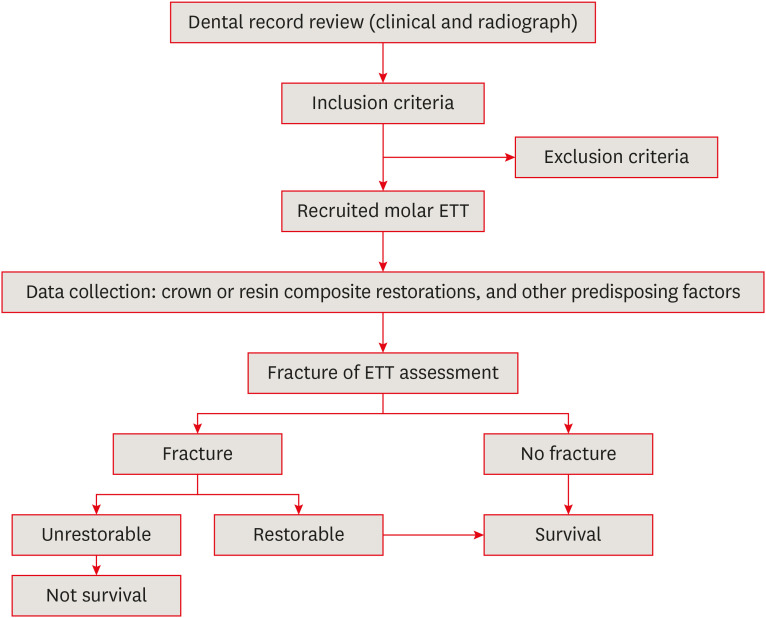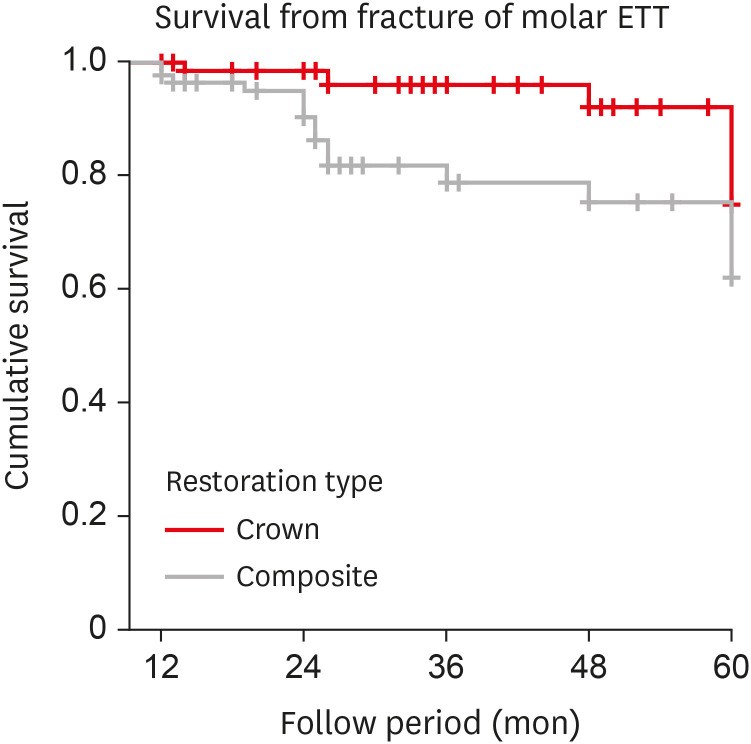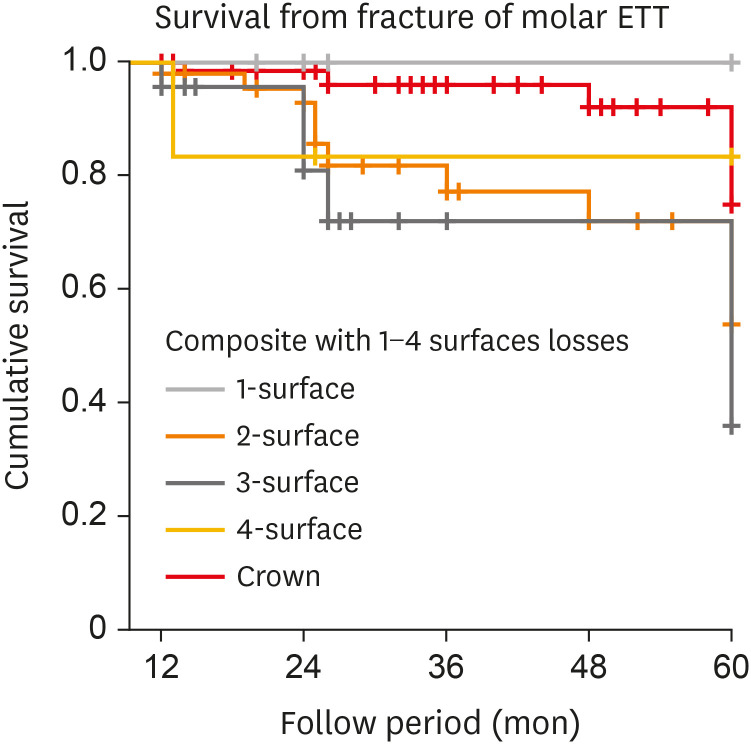Restor Dent Endod.
2021 May;46(2):e29. 10.5395/rde.2021.46.e29.
Retrospective study of fracture survival in endodontically treated molars: the effect of single-unit crowns versus direct-resin composite restorations
- Affiliations
-
- 1Department of Operative Dentistry and Endodontics, Faculty of Dentistry, Mahidol University, Bangkok, Thailand
- 2Department of Endodontics, College of Dental Medicine, Rangsit University, Pathum Thani, Thailand
- KMID: 2548073
- DOI: http://doi.org/10.5395/rde.2021.46.e29
Abstract
Objectives
This study was conducted to compare the post-fracture survival rate of endodontically treated molar endodontically treated teeth (molar ETT) restored with resin composites or crowns and to identify potential risk factors, using a retrospective cohort design.
Materials and Methods
Dental records of molar ETT with crowns or composite restorations (recall period, 2015–2019) were collected based on inclusion and exclusion criteria. The incidence of unrestorable fractures was identified, and molar ETT were classified according to survival. Information on potential risk factors was collected. Survival rates and potential risk factors were analyzed using the Kaplan-Meier log-rank test and Cox regression model.
Results
The overall survival rate of molar ETT was 87% (mean recall period, 31.73 ± 17.56 months). The survival rates of molar ETT restored with composites and crowns were 81.6% and 92.7%, reflecting a significant difference (p < 0.05). However, ETT restored with composites showed a 100% survival rate if only 1 surface was lost, which was comparable to the survival rate of ETT with crowns. The survival rates of ETT with composites and crowns were significantly different (97.6% vs. 83.7%) in the short-term (12–24 months), but not in the long-term (> 24 months) (87.8% vs. 79.5%).
Conclusions
The survival rate from fracture was higher for molar ETT restored with crowns was higher than for ETT restored with composites, especially in the first 2 years after restoration. Molar ETT with limited tooth structure loss only on the occlusal surface could be successfully restored with composite restorations.
Figure
Reference
-
1. Ng YL, Mann V, Gulabivala K. A prospective study of the factors affecting outcomes of non-surgical root canal treatment: part 2: tooth survival. Int Endod J. 2011; 44:610–625. PMID: 21366627.
Article2. Gillen BM, Looney SW, Gu LS, Loushine BA, Weller RN, Loushine RJ, Pashley DH, Tay FR. Impact of the quality of coronal restoration versus the quality of root canal fillings on success of root canal treatment: a systematic review and meta-analysis. J Endod. 2011; 37:895–902. PMID: 21689541.
Article3. Ray HA, Trope M. Periapical status of endodontically treated teeth in relation to the technical quality of the root filling and the coronal restoration. Int Endod J. 1995; 28:12–18. PMID: 7642323.
Article4. Sorensen JA, Martinoff JT. Intracoronal reinforcement and coronal coverage: a study of endodontically treated teeth. J Prosthet Dent. 1984; 51:780–784. PMID: 6376780.
Article5. Suksaphar W, Banomyong D, Jirathanyanatt T, Ngoenwiwatkul Y. Survival rates against fracture of endodontically treated posterior teeth restored with full-coverage crowns or resin composite restorations: a systematic review. Restor Dent Endod. 2017; 42:157–167. PMID: 28808632.
Article6. Fransson H, Dawson VS, Frisk F, Bjørndal L, EndoReCo O, Kvist T. Survival of root-filled teeth in the Swedish adult population. J Endod. 2016; 42:216–220. PMID: 26813417.
Article7. Aquilino SA, Caplan DJ. Relationship between crown placement and the survival of endodontically treated teeth. J Prosthet Dent. 2002; 87:256–263. PMID: 11941351.
Article8. Pratt I, Aminoshariae A, Montagnese TA, Williams KA, Khalighinejad N, Mickel A. Eight-year retrospective study of the critical time lapse between root canal completion and crown placement: its influence on the survival of endodontically treated teeth. J Endod. 2016; 42:1598–1603. PMID: 27625148.
Article9. Sedgley CM, Messer HH. Are endodontically treated teeth more brittle? J Endod. 1992; 18:332–335. PMID: 1402595.
Article10. Faria ACL, Rodrigues RCS, de Almeida Antunes RP, de Mattos Mda G, Ribeiro RF. Endodontically treated teeth: characteristics and considerations to restore them. J Prosthodont Res. 2011; 55:69–74. PMID: 20709618.
Article11. Panitvisai P, Messer HH. Cuspal deflection in molars in relation to endodontic and restorative procedures. J Endod. 1995; 21:57–61. PMID: 7714437.
Article12. Reeh ES, Douglas WH, Messer HH. Stiffness of endodontically-treated teeth related to restoration technique. J Dent Res. 1989; 68:1540–1544. PMID: 2584522.
Article13. Jirathanyanatt T, Suksaphar W, Banomyong D, Ngoenwiwatkul Y. Endodontically treated posterior teeth restored with or without crown restorations: a 5-year retrospective study of survival rates from fracture. J Investig Clin Dent. 2019; 10:e12426.
Article14. Dammaschke T, Nykiel K, Sagheri D, Schäfer E. Influence of coronal restorations on the fracture resistance of root canal-treated premolar and molar teeth: a retrospective study. Aust Endod J. 2013; 39:48–56. PMID: 23890259.
Article15. Corsentino G, Pedullà E, Castelli L, Liguori M, Spicciarelli V, Martignoni M, Ferrari M, Grandini S. Influence of access cavity preparation and remaining tooth substance on fracture strength of endodontically treated teeth. J Endod. 2018; 44:1416–1421. PMID: 30049468.
Article16. Linn J, Messer HH. Effect of restorative procedures on the strength of endodontically treated molars. J Endod. 1994; 20:479–485. PMID: 7714419.
Article17. Mannocci F, Bertelli E, Sherriff M, Watson TF, Ford TR. Three-year clinical comparison of survival of endodontically treated teeth restored with either full cast coverage or with direct composite restoration. J Prosthet Dent. 2002; 88:297–301. PMID: 12426500.
Article18. Suksaphar W, Banomyong D, Jirathanyanatt T, Ngoenwiwatkul Y. Survival rates from fracture of endodontically treated premolars restored with full-coverage crowns or direct resin composite restorations: a retrospective study. J Endod. 2018; 44:233–238. PMID: 29208401.
Article19. Nagasiri R, Chitmongkolsuk S. Long-term survival of endodontically treated molars without crown coverage: a retrospective cohort study. J Prosthet Dent. 2005; 93:164–170. PMID: 15674228.
Article20. Skupien JA, Cenci MS, Opdam NJ, Kreulen CM, Huysmans MC, Pereira-Cenci T. Crown vs. composite for post-retained restorations: a randomized clinical trial. J Dent. 2016; 48:34–39. PMID: 26976553.
Article21. Kumagai H, Suzuki T, Hamada T, Sondang P, Fujitani M, Nikawa H. Occlusal force distribution on the dental arch during various levels of clenching. J Oral Rehabil. 1999; 26:932–935. PMID: 10620156.
Article22. Ng YL, Mann V, Gulabivala K. Tooth survival following non-surgical root canal treatment: a systematic review of the literature. Int Endod J. 2010; 43:171–189. PMID: 20158529.
Article23. Chan CP, Lin CP, Tseng SC, Jeng JH. Vertical root fracture in endodontically versus nonendodontically treated teeth: a survey of 315 cases in Chinese patients. Oral Surg Oral Med Oral Pathol Oral Radiol Endod. 1999; 87:504–507. PMID: 10225635.
Article24. Lynch CD, McConnell RJ. The cracked tooth syndrome. J Can Dent Assoc. 2002; 68:470–475. PMID: 12323102.25. Lubisich EB, Hilton TJ, Ferracane J. Northwest Precedent. Cracked teeth: a review of the literature. J Esthet Restor Dent. 2010; 22:158–167. PMID: 20590967.
Article26. Hiatt WH. Incomplete crown-root fracture in pulpal-periodontal disease. J Periodontol. 1973; 44:369–379. PMID: 4513616.
Article27. Caplan DJ, Kolker J, Rivera EM, Walton RE. Relationship between number of proximal contacts and survival of root canal treated teeth. Int Endod J. 2002; 35:193–199. PMID: 11843976.
Article28. Lee AH, Cheung GS, Wong MC. Long-term outcome of primary non-surgical root canal treatment. Clin Oral Investig. 2012; 16:1607–1617.
Article29. Schwartz RS, Robbins JW. Post placement and restoration of endodontically treated teeth: a literature review. J Endod. 2004; 30:289–301. PMID: 15107639.
Article30. Scotti N, Coero Borga FA, Alovisi M, Rota R, Pasqualini D, Berutti E. Is fracture resistance of endodontically treated mandibular molars restored with indirect onlay composite restorations influenced by fibre post insertion? J Dent. 2012; 40:814–820. PMID: 22743344.
Article31. Salameh Z, Sorrentino R, Papacchini F, Ounsi HF, Tashkandi E, Goracci C, Ferrari M. Fracture resistance and failure patterns of endodontically treated mandibular molars restored using resin composite with or without translucent glass fiber posts. J Endod. 2006; 32:752–755. PMID: 16861075.
Article
- Full Text Links
- Actions
-
Cited
- CITED
-
- Close
- Share
- Similar articles
-
- Survival rates against fracture of endodontically treated posterior teeth restored with full-coverage crowns or resin composite restorations: a systematic review
- Post-endodontic Restoration on Erupting Permanent First Molars Using Endocrown with a Polyglass Composite Resin: Report of Two Cases
- 5 Year Cumulative Survival Rate of Composite Resin Restorations in Permanent First Molars
- Retrospective clinical and radiographic evaluation of restored endodontically treated teeth
- The effect of clinical performance on the survival estimates of direct restorations




